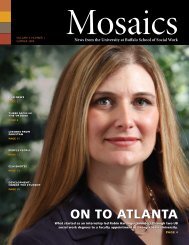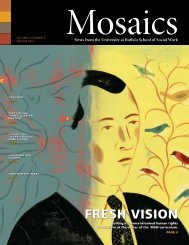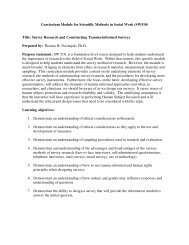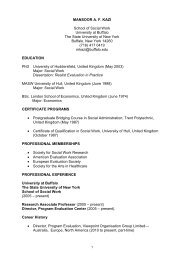Mosaics - UB School of Social Work - University at Buffalo
Mosaics - UB School of Social Work - University at Buffalo
Mosaics - UB School of Social Work - University at Buffalo
Create successful ePaper yourself
Turn your PDF publications into a flip-book with our unique Google optimized e-Paper software.
Wh<strong>at</strong> was it like then?<br />
The <strong>School</strong> <strong>of</strong> <strong>Social</strong> <strong>Work</strong> History Project has developed into a story about the stories<br />
<strong>of</strong> social workers and about the way the school has changed.<br />
By Jessica Perkins<br />
Because the stories in the History Project are real, some<br />
<strong>of</strong> the characters in them are frustr<strong>at</strong>ed by their experiences<br />
with the school and with the pr<strong>of</strong>ession, others<br />
are excited about their educ<strong>at</strong>ion and the p<strong>at</strong>hs it set them on. As<br />
any social worker knows, th<strong>at</strong>’s life.<br />
The earliest stories pred<strong>at</strong>e the birth <strong>of</strong> the parents <strong>of</strong> the<br />
current gener<strong>at</strong>ion <strong>of</strong> MSW students. George Lankes, MSW ’40,<br />
remembers when student loans were unheard <strong>of</strong>. At the end <strong>of</strong><br />
the Depression and the beginning <strong>of</strong> WWII, “everyone felt the<br />
financial pinch. The cost per gradu<strong>at</strong>e credit hour was expensive.<br />
Was it $10 or $20 per credit hour?”<br />
In a story from the 1950s, Charles Guzzetta, MSW ’54,<br />
reminds readers how far the school has come—or <strong>at</strong> least traveled.<br />
For anyone missing the “good ol’ days,” he remembers th<strong>at</strong><br />
“classes met [downtown] in Townsend Hall, a broken-down<br />
building near the Law <strong>School</strong> and City Hall. They tell me it’s a<br />
parking lot now. We could not have classes above the second<br />
story because <strong>of</strong> the danger <strong>of</strong> the floor giving way.”<br />
From the 1960s and early 70s, there are heady stories about<br />
the role <strong>of</strong> protest and about the people in the SSW who were<br />
advoc<strong>at</strong>es <strong>of</strong> social change. Gary M<strong>at</strong>hews (a research associ<strong>at</strong>e<br />
from 1969 to 1973) writes about a famous police raid: “The<br />
students massed in front <strong>of</strong> Foster Hall. The city police massed<br />
on Main Street, and for the first time in the<br />
history <strong>of</strong> the university, as far as I<br />
know, the police came charging<br />
up the hill, shooting canisters<br />
<strong>of</strong> tear gas and swinging their<br />
b<strong>at</strong>ons. The students came<br />
pouring through Foster Hall,<br />
seeking to flee. I asked [dean] Frank Zweig wh<strong>at</strong> he was going to<br />
do. He said, ‘I don’t know about you, but I am going through th<strong>at</strong><br />
window,’ pointing to the back side <strong>of</strong> the building.”<br />
Others recall those turbulent days as a wonderful time to be<br />
a social work student. “Our educ<strong>at</strong>ion suddenly became the realities<br />
<strong>of</strong> the world around us. It included things like a sit-in <strong>at</strong> the<br />
welfare department in downtown <strong>Buffalo</strong> in support <strong>of</strong> the families<br />
who had to sit there for many hours (or days) to wait to see a<br />
worker. We learned th<strong>at</strong> social workers are agents <strong>of</strong> change,” says<br />
Marian R<strong>of</strong>fman, BSW ’69, MSW ’71.<br />
If you are old enough to remember when Gestalt therapy<br />
was all the rage, you can rel<strong>at</strong>e to the story Will Fudeman, MSW<br />
’76, tells about how frustr<strong>at</strong>ed he was by the denial <strong>of</strong> his request<br />
to do an independent study in Gestalt. Like a good social worker,<br />
he recognizes th<strong>at</strong> confronting authority and pursuing cuttingedge<br />
practice was the right thing to do.<br />
Bonnie Collins, MSW ’80, writes about an important part <strong>of</strong><br />
her student experience: “I particularly enjoyed my field placement<br />
with a student unit <strong>at</strong> DSS under the supervision <strong>of</strong> Pr<strong>of</strong>essor<br />
Gerry Miller.”<br />
Ruth B<strong>at</strong>eman may have taken the longest time in the history<br />
<strong>of</strong> the school to finally get a degree. She started in 1940, but<br />
life intervened, as it <strong>of</strong>ten does, and she never finished the thesis<br />
th<strong>at</strong> was required <strong>at</strong> the time. In 1999, she received an honorary<br />
degree th<strong>at</strong> she “accepted with gre<strong>at</strong> joy.” Reading her story<br />
reminds social workers th<strong>at</strong> perseverance can pay <strong>of</strong>f.<br />
The story <strong>of</strong> the school’s first 75 years will get a concluding<br />
chapter <strong>at</strong> the 75th Anniversary Gala in October 2009. W<strong>at</strong>ch<br />
<strong>Mosaics</strong> for details. To learn more about the History Project, go<br />
to www.socialwork.buffalo.edu/about/historyproject.<br />
mosaics : Summer 2008 15














